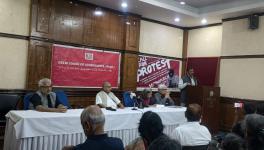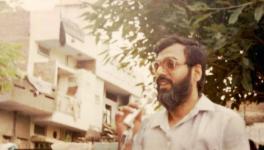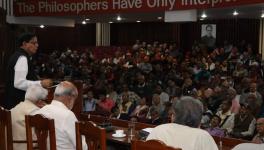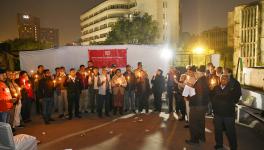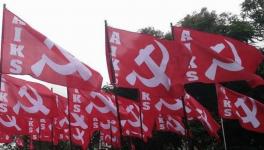Part I - "Fukushima - Undoubtedly the biggest nuclear disaster since Chernobyl"
Newsclick interviews Dr. A. Gopalakrishnan, former chairman of the Atomic Energy Regulatory Board in India on March 24, 2011. He speaks about the primary reasons for the continuing disaster in the Fukushima reactors following a major earthquake and tsunami in Japan.
Transcript-
Prabir Purkayastha (PP): Hello and welcome to Newsclick. Today we have with us Dr. Gopalakrishnan, former Chairman of the Atomic Energy regulatory Board and a very well known nuclear engineer. Let's first have a look at the Fukushima reactors and what has happened there.
Gopal, if you look at these reactors. This is unit one, two, three and four before the explosion took place. Five and six are more to the side of unit one. If we look at this one, this is where unit five and six are, which are not affected and this is what you see as result on the explosions that took place. This is a more detailed view of the four reactor buildings which were affected. Unit one, two three and four, as you can see, three of the buildings are virtually dismantled. In unit two, what is called the second containment, is more or less intact but some steam is escaping here, so there is some damage as well. But these are the reactors which have really been affected. Unit one, two and three and the fourth because of the fire in the storage pools. If you look at the situation today as it stands power has been restored to Unit one and two control rooms. The power has come on there, but it doesn't mean the equipment is working. Even now, what seems to be happening is that the power is more to see the instruments and maybe try and restore some of the controls from the control room because the radio activity in the area is quite high. So if you're in the control room the operations become a little easier. As far as power is concerned for unit three and four, they have still not restored the power in control room. We don't know what the state of the inside of the building is.
Unit four and three both have additional problems in fact, unit four was shut down as well as unit five and six. Unit four had the problem of the storage ponds, the intermediate storage ponds.
Both have caught fire and unit four, in fact, the destruction of the building is because of the fire in the storage tanks. Unit three had a problem with the reactor as well as also the storage tank catching fire. Interestingly enough units two and three the primary containment also seems to have been breached. Though the breach may not be very large, it still seems to have been breached. So we have a situation where we have effectively still a crisis in these four reactors. Storage ponds-
two of them are still in trouble. The cooling systems are still not working for any of them.
There is some control but it is really with a completely makeshift arrangement. Putting in fire water pumps, basically some water canons they have brought from outside, seawater and boron being pumped into the reactors and so the situation still is very much on the edge but it is not heading towards a meltdown as it was feared earlier. But it still seems that the situation is pretty much tense as it stands on the ground.
As you've seen, containment seems to have failed in two of the reactors. This has been expressed as a well-known problem with the mark one vintage of reactors. Is that correct?
Dr A Gopalakrishnan: It is correct actually because the containment cannot stand too much over-pressure and that's the reason that they have built in a suppression pool in that and which means that the steam would come out in the case of a break is first taken into a pool of a water which is contained in a Taurus and the attempt is to condense as much as steam so that the partial pressure of the steam will not add on to the containment pressure. But later on it turned out that that suppression pools itself could cause a problem because most likely the resulting dynamics of water, bubbles inside, would probably tend to break the suppression pools’ arms and the legs which are coming in.
So there was major study connected with that and many of the reactors cannot be retrofitted for correcting that. So I would think that most of the marked ones would stay with a weak containment and secondary mechanisms that was designed in to take care of it is also not working.
PP: If you look at it, this is a very serious issue because after all the four reactors which have been affected- three of them which were operating- and the problems of over heating, residual heat not been carried, explosions and also two of them had reactors storage ponds which have had serious problems. Now, looking at it one would say that this is really the biggest disaster after Chernobyl because four reactors which are still very difficult to control.
AG: Certainly, I think it is undoubtedly the biggest disaster. In some it could of course, Chernobyl you could not compare because there the reactor was operating and there was no effective containment at all. But here with four reactors and most likely all the four would begin to release radioactivity. It's a slowly developing accident but day by day it's getting worse and it could end up in some total being very serious because where will people be evacuated to. I mean Tokyo is affected today, beginning to be affected; even water is getting affected, so I think it's only a matter of few more days before the situation will be much more serious.
PP: Even if there is no large scale radio activity released it still would mean that they have to keep it in this condition for the next couple of months if not three to four months before they can think of decommissioning the reactors.
AG: At least the heating rate will very gradually come down. But as you rightly said it will take at least a couple of months but it will never come down to zero. It will be going down I think it will take few more months before it comes down to fifty percent of what it is today and you can keep on pouring water on the on top of it but you really are not sure whether the water is reaching all the places where it should reach, specially the storage pools, where the water level is probably low.
So most likely the releases are taking place from the overheated fuel in the pools that they have been stored in.
PP: Storage ponds are the more critical issue today.
AG: Yes. I think it will continue to be the critical issue because if you keep on directing water from the water jets and water from the helicopter and all that, some is bound to reach the reactor core. The core will be getting wet from time to time because of this, but the pool may be on the side without water for a long time and so the overheated elements may be there. The fact that there is release of iodine and caesium, which is being found, shows that the plant is melting and releases are taking place from within the fuel. That's indicative of the species which are coming out. So, one will have to track the level of caesium and iodine really closely, to see how the accident is really progressing.
PP: Gopal, the long term solution for these reactors, at least these four reactors, needs to be decommissioning. Now how do you really decommission the reactors when already you have the building destroyed, equipment not working, and the reactor storage pools, intermediate storage pools which are having problems, located at the fourth floor of the building?
AG: I think the decommissioning in the sense of completely dismantling and disposing of these parts will come only much later, because I think the many other parts, because the reactors have been operating for years, would be very highly radioactive and operations can only be done with remote handling and remote carting. So with today's condition of those reactors even equipment cannot be taken in. I think it'll have to be fenced off and a large area may have to be left alone, but only thing you can do is something like the Chernobyl solution, ultimate solution of having poured cement sand mixtures etc., that that can be done.
If you put it right now, there is a likelihood that the fuel may still be cooking inside and it will get overheated and the whole thing will again get expelled so if you wait long enough for the reactors to cool and it's reasonably cool from the temperature point of view. You could attempt to bury it for some time because the burial will also mean that the radioactivity escaping into the air will be minimized, if not stopped, and also the shielding provided with this will probably allow people to move around the reactors, to work, with a little bit more ease. So there will be several stages of the work first before you start really talking about decommissioning.
PP: Storage pools- entombing them is not an option either, the fourth floor will come cracking down.
AG: But there, if fuel is not highly exposed and molten, it can probably be individually put into steel casts and can be taken out and given cooling elsewhere somewhere in the compound. So it could be taken out from that area and sealed and cooled. Perhaps a cooling device system may have
to be engineered. There is something you can do with the fuel, which is sitting there as long as it has not melted and slumped. Because if it has melted and slumped, burial will be the only solution there also, but if it can be me individually taken out, there's a possibility that some temporary storage in casks can be done.
PP: We must also really congratulate Japanese engineers, technicians for having really braved a very difficult situation there.
AG: Certainly I think I would even say that the fact that many other buildings including the reactor, which withstood a very serious earthquake, which was not very far from the shore that goes to the credit of the Japanese engineering. In spite of this accident and what happened, it only reinforces the fact that the Japanese are the best earthquake engineers in the world and on the Tsunami also they tried their best. But in every design you look for what is the maximum credible accident that can happen and I think this somehow went beyond that maximum anybody could think of.
PP: Also, the argument of placing the back up Digiset in the bunkers was that if there is a typhoon or an aerial accident or bombing, the bunkers are better. So in fact, if that had happened we might have said you should have put it underground, why did they put it in elevated place, if they have done that? So either way accidents are really something you don't always engineer for. All possibilities cannot be engineered against.
AG: Even if at least one diesel set was somewhere at an elevation or away location away from the Tsunami and it had independent cabling coming to these reactors It could have helped the situation. So I think in retrospect one can say that level of safety engineering thinking may not have been done. It's easy to say today, but I am sure none of us would have thought about it.
Get the latest reports & analysis with people's perspective on Protests, movements & deep analytical videos, discussions of the current affairs in your Telegram app. Subscribe to NewsClick's Telegram channel & get Real-Time updates on stories, as they get published on our website.











